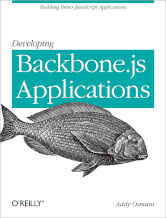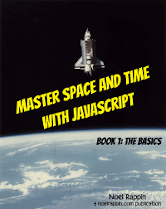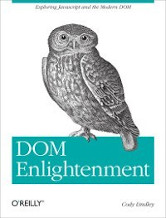Last Updated on February 14, 2025
7. Developing Backbone.js Applications by Addy Osmani
 This book teaches you how to create structured JavaScript applications, using Backbone’s own flavor of model-view-controller (MVC) architecture. Backbone.js is a lightweight JavaScript library that adds structure to your client-side code. It makes it easy to manage and decouple concerns in your application, leaving you with code that is more maintainable in the long term.
This book teaches you how to create structured JavaScript applications, using Backbone’s own flavor of model-view-controller (MVC) architecture. Backbone.js is a lightweight JavaScript library that adds structure to your client-side code. It makes it easy to manage and decouple concerns in your application, leaving you with code that is more maintainable in the long term.
Learn the essentials of Backbone’s models, views, collections, events, and routers. The book also looks at two popular Backbone add-ons: MarionetteJS and Thorax. Marionette simplifies your Backbone application code with robust views and architecture solutions. Thorax is used to build meaty Backbone applications.
The book is targeted at novice to intermediate developers. It is released under a Creative Commons Attribution-Noncommercial-No Derivative Works 3.0 United States License.
8. Master Space and Time with JavaScript by Noel Rappin
 Master Space and Time in JavaScript is a four book series aimed at developers who have a basic knowledge of JavaScript but who need to learn about newer tools and practices.
Master Space and Time in JavaScript is a four book series aimed at developers who have a basic knowledge of JavaScript but who need to learn about newer tools and practices.
The 4 books:
- The Basics – contains an introduction to Jasmine testing and jQuery, plus a look at JavaScript’s object model.
- Objects in JavaScript – more complete examples of using and testing objects in JavaScript, including communication with a remote server and JSON.
- Backbone – continues building the website using Backbone.js to create single-page interfaces for some more complex user interaction.
- Ember – builds out completely different parts of the website using Ember.js to create complex client-side interactions.
Sadly the author has removed all the books from his website. The series was released under a Creative Commons license. If you know where a copy of the books are available, please let us know.
9. DOM Enlightenment by Cody Lindley

DOM Enlightenment teaches you how to manipulate HTML more efficiently by scripting the Document Object Model (DOM) without a DOM library. Using code examples in cookbook style, the author explains modern DOM concepts to illustrate how various node objects work.
The book is targeted at developers who want to understand the purpose and value provided by jQuery for scripting the DOM. The author also wants to help developers tasked with scripting web documents that only run on modern browsers.
Chapters cover:
- Node overview – examines node object types, properties and methods for working nodes, getting a nodes value and more.
- Document nodes – includes document child nodes, detecting DOM specifications/features using document.implementation.hasFeature().
- Element nodes – create elements, get the tag name of an element, verifying an element has a specific attribute and more.
- Element node selecting – selecting/creating a NodeList, contextual element selecting, and more.
- Element node geometry & scrolling geometry – shows how to use getBoundingClientRect(), elementFromPoint(), scrollHeight, scrollWidth, scrollIntoView().
- Element nodes inline style – CSS properties.
- Text nodes – good treatment on manipulating text.
- DocumentFragment nodes – creation and use of DocumentFragment nodes.
- CSS style sheets & CSS rules – including how to create a new inline CSS style sheet.
- JavaScript in the DOM – covers <script> element node, how to use defer, async, and more.
- DOM events – DOM event types, the event flow, adding event listeners to element nodes, window object, and document object.
- Creating dom.js.
The DOM Enlightenment HTML version is released under a Creative Commons Attribution-Noncommercial-No Derivative Works 3.0 unported license.
Next page: Page 4 – jQuery Fundamentals and more books
Pages in this article:
Page 1 – You Don’t Know JS (book series) and more books
Page 2 – JavaScript Enlightenment and more books
Page 3 – Developing Backbone.js Applications and more books
Page 4 – jQuery Fundamentals and more books
Page 5 – JavaScript Bible and more books
Page 6 – Object-Oriented JavaScript and more books
All books in this series:
| Free Programming Books | |
|---|---|
| Ada | ALGOL-like programming language, extended from Pascal and other languages |
| Agda | Dependently typed functional language based on intuitionistic Type Theory |
| Arduino | Inexpensive, flexible, open source microcontroller platform |
| Assembly | As close to writing machine code without writing in pure hexadecimal |
| Awk | Versatile language designed for pattern scanning and processing language |
| Bash | Shell and command language; popular both as a shell and a scripting language |
| BASIC | Beginner’s All-purpose Symbolic Instruction Code |
| C | General-purpose, procedural, portable, high-level language |
| C++ | General-purpose, portable, free-form, multi-paradigm language |
| C# | Combines the power and flexibility of C++ with the simplicity of Visual Basic |
| Clojure | Dialect of the Lisp programming language |
| ClojureScript | Compiler for Clojure that targets JavaScript |
| COBOL | Common Business-Oriented Language |
| CoffeeScript | Transcompiles into JavaScript inspired by Ruby, Python and Haskell |
| Coq | Dependently typed language similar to Agda, Idris, F* and others |
| Crystal | General-purpose, concurrent, multi-paradigm, object-oriented language |
| CSS | CSS (Cascading Style Sheets) specifies a web page’s appearance |
| D | General-purpose systems programming language with a C-like syntax |
| Dart | Client-optimized language for fast apps on multiple platforms |
| Dylan | Multi-paradigm language supporting functional and object-oriented coding |
| ECMAScript | Best known as the language embedded in web browsers |
| Eiffel | Object-oriented language designed by Bertrand Meyer |
| Elixir | Relatively new functional language running on the Erlang virtual machine |
| Erlang | General-purpose, concurrent, declarative, functional language |
| F# | Uses functional, imperative, and object-oriented programming methods |
| Factor | Dynamic stack-based programming language |
| Forth | Imperative stack-based programming language |
| Fortran | The first high-level language, using the first compiler |
| Go | Compiled, statically typed programming language |
| Groovy | Powerful, optionally typed and dynamic language |
| Haskell | Standardized, general-purpose, polymorphically, statically typed language |
| HTML | HyperText Markup Language |
| Icon | Wide variety of features for processing and presenting symbolic data |
| J | Array programming language based primarily on APL |
| Java | General-purpose, concurrent, class-based, object-oriented, high-level language |
| JavaScript | Interpreted, prototype-based, scripting language |
| Julia | High-level, high-performance language for technical computing |
| Kotlin | More modern version of Java |
| LabVIEW | Designed to enable domain experts to build power systems quickly |
| LaTeX | Professional document preparation system and document markup language |
| Lisp | Unique features - excellent to study programming constructs |
| Logo | Dialect of Lisp that features interactivity, modularity, extensibility |
| Lua | Designed as an embeddable scripting language |
| Markdown | Plain text formatting syntax designed to be easy-to-read and easy-to-write |
| Objective-C | Object-oriented language that adds Smalltalk-style messaging to C |
| OCaml | The main implementation of the Caml language |
| Pascal | Imperative and procedural language designed in the late 1960s |
| Perl | High-level, general-purpose, interpreted, scripting, dynamic language |
| PHP | PHP has been at the helm of the web for many years |
| PostScript | Interpreted, stack-based and Turing complete language |
| Prolog | A general purpose, declarative, logic programming language |
| PureScript | Small strongly, statically typed language compiling to JavaScript |
| Python | General-purpose, structured, powerful language |
| QML | Hierarchical declarative language for user interface layout - JSON-like syntax |
| R | De facto standard among statisticians and data analysts |
| Racket | General-purpose, object-oriented, multi-paradigm, functional language |
| Raku | Member of the Perl family of programming languages |
| Ruby | General purpose, scripting, structured, flexible, fully object-oriented language |
| Rust | Ideal for systems, embedded, and other performance critical code |
| Scala | Modern, object-functional, multi-paradigm, Java-based language |
| Scheme | A general-purpose, functional language descended from Lisp and Algol |
| Scratch | Visual programming language designed for 8-16 year-old children |
| SQL | Access and manipulate data held in a relational database management system |
| Standard ML | General-purpose functional language characterized as "Lisp with types" |
| Swift | Powerful and intuitive general-purpose programming language |
| Tcl | Dynamic language based on concepts of Lisp, C, and Unix shells |
| TeX | Markup and programming language - create professional quality typeset text |
| TypeScript | Strict syntactical superset of JavaScript adding optional static typing |
| Vala | Object-oriented language, syntactically similar to C# |
| VHDL | Hardware description language used in electronic design automation |
| VimL | Powerful scripting language of the Vim editor |
| XML | Rules for defining semantic tags describing structure ad meaning |

sorry 8- Link ????
All the links are working